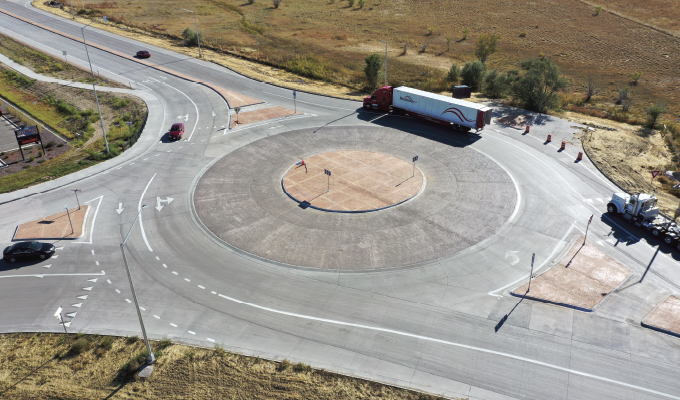As a rigid surface that isn’t prone to rutting or shoving, concrete pavement is well suited to handle the stresses and heavy loading inflicted on roundabouts. However, because of the challenging geometry of roundabouts and other intersections, specialized design and construction considerations come into play.
The biggest consideration for concrete roundabouts is the spacing, type, and layout of joints. All concrete pavement is jointed to control the location of cracks. Conventional concrete pavements can be jointed in a rectilinear pattern, but complex geometries of roundabouts and other intersections create a jointing challenge. For roundabouts, given their curvature and non-standard shapes, rectilinear jointing leads to odd-shaped slabs and does not guide drivers through the circular roadway. In addition to safety and constructability considerations, this can lead to improper load transfer and increased wear.
JOINTING STRATEGY
At the outset of the roundabout design, engineers and contractors should adopt a jointing strategy and lay out a detailed joint plan. One strategy is to pave the circle separately from the incoming roads, or approach legs. This is known as the “isolated circle” approach. Another common method is to carry one of the incoming roadway’s pavements through the roundabout, leaving the remaining legs isolated. This is known as the “pave through” method. Both ensure joints in the circular portion radiate from the center, and joints in the legs are normal or perpendicular to the edge of the pavement.
When developing a detailed jointing plan, general rules are to:
- Place joints to meet in-pavement structure.
- Match existing joints or cracks, both location and type.
- Calculate and abide by maximum joint spacing.
- Place isolation joints where needed.
- Cut joints at the proper time and to the proper depth.
- Understand that joint locations can be adjusted in the field.
Things to avoid include:
- Slabs that are too small or too large; slabs should be in the range of 2 to 15 feet.
- Angles that are less than 60 degrees; small angles encourage cracks to take a shorter or different path than the one intended with the saw cut. Ninety-degree angles are best.
- Creating interior corners and odd-shaped slabs; keep slabs nearly square or rectangular, when possible.
Free tools, such as WikiPave and PavementDesigner, are available to walk designers through the steps of developing a jointing plan and pavement design.
PAVING THICKNESS
Pavement thickness is also a variable in roundabout construction. At-grade intersections of residential, collector, and business roadways generally will not require any extra concrete thickness. Roundabout-area pavement thickness can be the same as the thicker of the two approaching roadways. For intersections involving roadways carrying high levels of trucks (such as with industrial and arterial roadways), the roundabout area may require as much as 0.5-1.0 inches of additional thickness. A design tool like PavementDesigner.org is recommended for determining the thickness for each roadway and calculating the combined traffic through the intersection. If additional thickness is warranted, it is pragmatic to apply the controlling thickness for the entire functional area of the roundabout, including the approach legs. The transition from thinner roadways into a thicker intersection is generally best kept at a location before the radii for the intersection. A transition length of about 3 to 6 feet for changing the thickness is usually adequate.
The same materials and mix design specifications can be used for roundabouts that would be used on other concrete roadways, although it may be necessary to adjust the mix to accommodate placement method (i.e., slipform paving, fixed form with screed, hand-finished, or pumped).
TRAFFIC MANAGEMENT
Accommodating traffic, especially in urban areas, should also be considered during a roundabout’s design and planning stages. A phasing plan can determine how to maintain traffic flow during construction. Roundabouts generally require more phases than standard concrete paving, depending on the size of the roundabout (diameter), number of lanes in the circulating roadway, and the style of design employed. While complete or partial closures are optimal from a cost and time perspective, if work needs to be performed under traffic, it is usual to perform work in the driving lanes of the major roadway before those of the crossroad. Concentrating on the major roadway pavement generally produces a smoother-riding intersection. One common method for constructing roundabouts while maintaining traffic is to create a temporary bypass, which allows the contactor to build the circular roadway without disruption.
About the Author:
Eric Ferrebee, P.E., is senior director of technical services for American Concrete Pavement Association. The ACPA is the national trade association for the concrete pavement industry. ACPA’s mission is to develop and protect concrete pavement markets through education, advocacy, marketing, and industry technical leadership. For more, visit www.acpa.org.
Modern Contractor Solutions, May 2024
Did you enjoy this article?
Subscribe to the FREE Digital Edition of Modern Contractor Solutions magazine.



